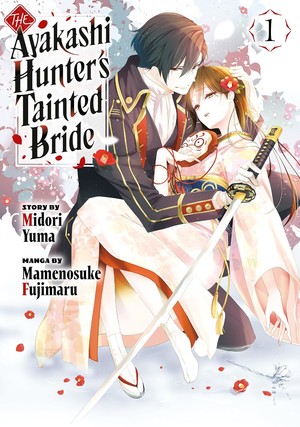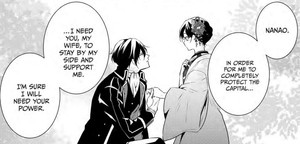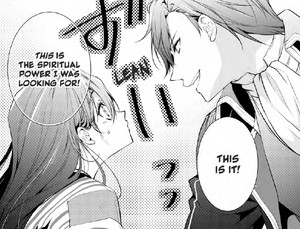The Spring 2025 Manga Guide
The Ayakashi Hunter's Tainted Bride
What's It About?

The Ayakashi Hunter's Tainted Bride has a story and art by Mamenosuke Fujimaru, based on the work by Midori Yūma, with English translation by Jacqueline Fung. This volume is lettered by Madeleine Jose. Published by Kodansha Comics (March 25, 2025). Rated 16+.
Is It Worth Reading?
Dee
Rating:

This series sounds so fun on paper (curses! evil relatives! demon wars! shikigami! and vampires?!), but the execution is mostly giving “We have My Happy Marriage at home.”
As a big fan of historical fantasies, I've spent the day trying to figure out why The Ayakashi Hunter's Tainted Bride left me so cold, and I think the reasons are threefold. First, the art is a bit generic. It has that digital, overly polished look that tends to smooth out any unique edges. Other than some striking images of Nanao's monkey mask, the style doesn't give the supernatural elements much panache.
Second, just like the art, the character writing is also a bit generic. Nanao is a typical passive Cinderella, waiting to be rescued and just happy to be needed. (Dear authors: please read older Cinderella variants where she's an active, clever heroine who facilitates her own rescue.) With the exception of Nanao's dad, her relatives are all cartoonishly wicked. Yako fares a bit better thanks to a touch of moe bashfulness, and Nanao and Yako bonding over their curses creates a potentially strong romantic throughline. Beyond that, there's not much to help distinguish these characters from other, similar stories.
The third reason is more personal, but still worth noting for prospective readers: this world's magic system is founded on gendered stereotypes that combine yin/yang philosophy with “separate sphere” beliefs. Men possess light spiritual power, so they work outside the home; women possess dark spiritual power, so they stay home, perform rituals, and provide meals. In Nanao's case, those meals also include her own blood, really hammering home how this society sees her as more Instant Pot than person. Maybe the series will challenge that worldview in future volumes, but it sure didn't here.
I'm probably being too hard on The Ayakashi Hunter's Tainted Bride, but the premise sounded like a home run for me and it barely got on base. It's a lot of familiar archetypes and story beats without a lot of consideration for how those elements are used or what they mean for the characters and story as a whole. Not even Surprise Vampires could win me over. It's not unsalvageable, but unless I hear that Nanao develops some agency and goals beyond “feed hubby,” I won't be back for more.
Rebecca Silverman
Rating:

It's almost impossible to read The Ayakashi Hunter's Tainted Bride without thinking about My Happy Marriage. That's largely due to surface similarities: the stories both take place in a fantasy Taisho era and star heroines who were abused by their families, only to be whisked away in marriage to a powerful man. Take out the “Taisho” bit, though, and you have quite frankly a lot of series, both western and eastern, in no small part because of the worldwide prevalence of the Cinderella tale type. But I think that, given the chance, this series may turn out to be its own thing and strong enough on its own merits to appeal to readers, in no small part because the script is written by Midori Yūma, the author of Kakuriyo – Bed and Breakfast for Spirits.
Still, this volume does make it hard to look past the familiar elements. Heroine Nanao was treated horribly by her family because of the actions of her jealous cousin Akemi, who tricked her into becoming tainted by leaving the barrier keeping ayakashi out of the family estate. For all intents and purposes, she's a wicked stepsister, although the stealing of Nanao's illustrious fiancé Reito speaks more of a different fairy tale, “The White Bride and the Black One,” ATU403a. Akemi's cruelty determines Nanao's life from her fall from grace to her rescue by Yako, heir to a different clan, and I'm very afraid that we haven't seen the last of her, because the final chapter reveals that Reito is beginning to figure out what his wife has been up to.
Not that Reito's any prize himself, and the near total lack of any likable characters is a hurdle for this volume. Even Yako isn't great shakes, although he does try to be; his naturally caustic demeanor turns him into more of the dark and brooding hero than I think he's meant to be. And he does at least really care for Nanao; his rescue of her is only partially motivated by wanting a bride from her family while the rest comes down to simply wanting to help someone in a terrible position. He and Nanao both need a lot more character development to make the story truly work, which ultimately is why I say this is worth giving a second volume to see where it goes.
Right now this feels like a collection of cogs that aren't quite connecting. It has folkloric elements in both fairy tales and ayakashi sitings, a recognizable romance that risks budding into a love triangle if Reito can keep his head out of his ass, and characters with some potential. Mamenosuke Fujimaru, whose art is best known from the roughly four hundred Alice in the Country of _____ manga adaptations, has some trouble with faces, but overall does a nice job with layouts, and everyone is appropriately attractive. I'm tentatively hopeful for this – just because it's telling a familiar story doesn't mean that it's not a story worth reading.
discuss this in the forum (28 posts) |
this article has been modified since it was originally posted; see change history
back to The Spring 2025 Manga Guide
Seasonal homepage / archives